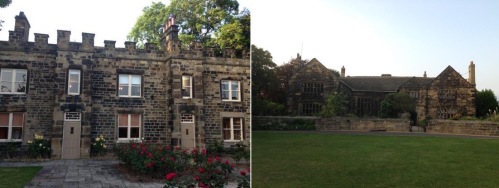One of my Christmas holiday viewing highlights was “To Walk Invisible.” Sally Wainwright’s drama focused on the years between 1845-1848, with the four surviving Brontë siblings and their father all together in Haworth. It portrayed Charlotte, Emily and Anne’s journey to become published authors, set against the backdrop of their increasingly bitter brother Branwell’s spiralling alcohol-fuelled (possibly with a touch of opium thrown in) decline and the bleak, isolation of their Haworth home. The Rev Patrick Brontë is shown as a distant but gentle figure, struggling with his failing eyesight and vainly trying to halt his beloved only son’s self-destruction.
It is a story that has fascinated me. Haworth is on my doorstep, a short drive away, and a place I’ve visited frequently ever since childhood. The Parsonage Museum, the church of St Michael’s and wandering round its overcrowded Victorian graveyard, and a walk to Brontë Falls and onwards to Top Withens (Wuthering Heights) all feature on my things I like to do list. Although I have to be in an energetic mood for the latter. If not, a mooch up and down the cobbled Main Street, including the Black Bull frequented by Branwell is an alternative. Last year I, along with many others, walked from Haworth village to Penistone Hill to see the film set recreation of the Parsonage.
But even within minutes of my home there are a host of Brontë connections. The Rydings in Birstall was the early home of Ellen Nussey, Charlotte’s close friend who witnessed her marriage to Arthur Bell Nicholls in June 1854. The Rydings is believed to be the basis of Thornfield Hall in arguably Charlotte’s best known novel, “Jane Eyre”. Although not accessible to the general public, I was lucky enough to visit a few years ago on a Malcolm Haigh History Walk. Oakwell Hall, also in Birstall, right on my doorstep and a jewel in the crown of Kirklees Council, is the inspiration for Fieldhead in Charlotte’s novel “Shirley.” I have attached the link to a leaflet about local Brontë connections. Sadly Kirklees Council in its 2016 cut-backs permanently closed Red House Museum in Gomersal, home of another of Charlotte’s friends, Mary Taylor, and Briarmans in “Shirley.” The leaflet also highlights several local churches. Patrick Brontë was ordained into the Church of England as a deacon in 1806 and priest in 1807. He is most associated with Haworth, being appointed Perpetual Curate of Haworth, Stanbury and Oxenhope in 1820, and remaining there until is death in 1861. However, prior to this appointment he held curacies at a number of other churches. The places associated with him are:- Wethersfield, Essex (1806-1809), Parish Registers for St Mary Magdalene are available on Essex Archives Online
- Wellington, Shropshire (1809). Parish Registers on FindMyPast
- Dewsbury, Yorkshire (1809-1811), Parish Registers on Ancestry.co.uk and Bishop’s Transcipts (BTs) of them on FindMyPast
- Hartshead-cum-Clifton, Yorkshire (1811-1815). Maria Brontë’s baptism took place here. She was the eldest of the Brontë children and died in 1825. BTs are on FindMyPast.
- Thornton, Yorkshire (1815-1820). This is where Charlotte, (Patrick) Branwell, Emily and Anne were baptised, along with sister Elizabeth who died in 1825. The BTs of the registers, including these Brontë baptisms, are on FindMyPast.
So if you have ancestors who were baptised, married or buried in these places, check the parish registers for the name of the minister. See if it was Patrick Brontë (or the early variant Brunty which appears in the Hartshead BTs). One word of caution. Pre-1813 registers were not standardised, so naming the person performing the ceremony prior to that date may only extend to marriages. From 1 January 1813, following Rose’s Act of 1812, printed paper registers with a standardised format included details of the person officiating, so this includes for baptisms and burials as well as marriages.
I did check, having ancestors in Hartshead, Dewsbury and Thornton. But unfortunately they are fractionally either side of the relevant dates for Patrick Brontë. One lot were, in any case,nonconformists. So I was unsuccessful in finding that hoped-for Brontë family connection to add family history colour.
However you may be luckier. You never know, you might find the officiating minister was Patrick Brontë, father of these literary legends. So you might have your very own (tenuous) Brontë link in your family history story.
Sources:
- Ancestry.co.uk: https://www.ancestry.co.uk/
- Clergy of the Church of England Database: http://theclergydatabase.org.uk/
- Essex Archives Online: http://seax.essexcc.gov.uk/
- FindMyPast: http://www.findmypast.co.uk/
- The Brontë Society: https://www.bronte.org.uk/
- The Brontës in Pennine Yorkshire: https://www.kirklees.gov.uk/leisure/museumsGalleries/pdf/bronteYorkshire.pdf



I stumbled across this website whilst google searching some Dewsbury and Batley folk for my family history research. I have spent the last 3 days reading through the archives, the external links, categories, etc. I live in Australia and have thoroughly enjoyed the stories and the photographs. What a fabulous site which I have now bookmarked – Thank you
Thank you Sandra for getting in touch to let me know how much you like this blog. I really appreciate it. It’s great to know what I’m writing is being enjoyed by others and hopefully helping them research their family history.
Best wishes
Jane
Pingback: The Accidental Blogger – My 2017 Review | PastToPresentGenealogy